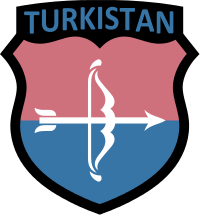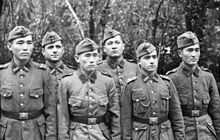Turkestan legion

The Turkestan Legion (German: Turkistanische Legion) was the name for the military units composed of the "freiwillige" Turkic peoples who fought in the German Army during World War II. Most of these troops were Red Army POWs, who opted to fight for the Nazis in the hopes of establishing an independent state in Central Asia after the war.
The battalions of the Turkistani Legion formed part of the 162nd Infantry Division and saw much action in Yugoslavia and Italy.
Although Turkic peoples had been perceived initially as "racially inferior", this attitude officially already changed in the Autumn 1941, when the Nazis attempted to harness the anti-Russian sentiment of Turkic peoples in Russia for political gain. The first "Turkistan Legion" was mobilized in May 1942, originally consisting of only one battalion but having been expanded to 16 battalions and 16,000 soldiers by 1943. Under the Wehrmacht's command, these units were mobilized exclusively on the Western front, isolating them from the Red Army, on the war fronts of France and north Italy.
Much of the Turkestan Legion was ultimately imprisoned by British forces and repatriated into Russia, where they would face gulag camps or prison terms from the Soviet government for having fought alongside the Axis forces.
Notable members of the legion include Baymirza Hayit, who after the war, settled in West Germany and became a historian of the history of Central Asia and Turkestan.

See also
References
- Flagmaster Nr. 105, Summer 2002, Publikation von „The Flag Institute“, Mayfair, London, W1J5NS, United Kingdom
Further reading
- Sakal, Halil Burak (2013). Başka Bir Dünya Savaşı: İkinci Dünya Savaşı Sırasında Almanya Tarafında Savaşan Türkistanlılar. Ötüken. ISBN 978-975-437-981-5.